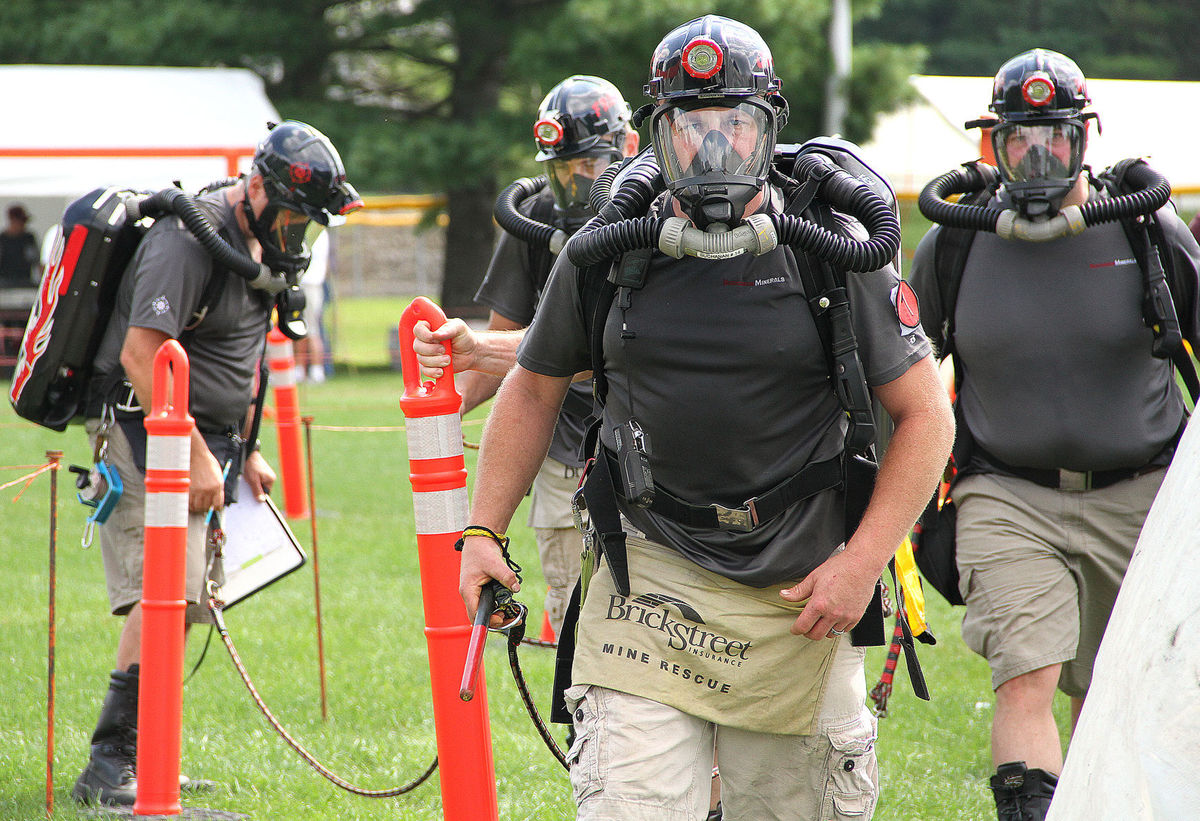Despite Industry Declines, Mine Rescue Teams Train for Emergencies

By Tonia Moxley
August 10, 2017 - It was like pre-cellphone times at Blacksburg, Virginia's Community Center basketball court this week as mine search and rescue teams shot hoops, swapped stories and fiddled with equipment at the 38th annual Virginia Mining Institute Mine Rescue Contest.
The men had no choice but to give up technological distractions; organizers took away their smartphones. Not only that, but guards posted at the entrances kept them in “lockup.” It was all to ensure that nobody got a look at the challenge course before it was their turn to run it.
On the athletic field outside, judges followed rescue teams in full gear around in the sun as they tested themselves in a simulated mine disaster. They encountered equipment failures, entrapped miners and dangerous levels of toxic gasses. The event was timed, and the team with the best performance overall will receive a trophy and bragging rights at a ceremony Thursday.
“One thing [Virginia Mining Institute] has always held true is quality,” said Wayne Davis, contest coordinator and designer. “We stress them physically and mentally. If they’re ever called to a disaster, that’s what they’ll be in.”
The competition lasts three days and covers every aspect of mine search and rescue. The institute dates to the late 1960s and focuses on mine safety training and professional development. The group has been running the contest since 1972, and it’s been held in Blacksburg since 1978, Davis said.
The training is important. Every mine is required to have a certified rescue team and a backup team within a one-hour drive of the mine site, according to Tarah Kesterson, spokeswoman for the Virginia Department of Mines, Minerals and Energy.
Each team is made up of mine workers, from roof bolters (also known as “pin men”) and engineers to foremen and electricians, who have volunteered to help their fellows in the direst of emergencies.
The last major mining disaster in Virginia happened on Dec. 7, 1992, when an explosion at Mine No. 3 of the Southmountain Coal Company in Norton killed eight miners.
Bob Baker started his career at 18 in New Mexico potash mines and worked his way up to be a federal mine inspector enforcing safety rules in Virginia. He retired 11 years ago but comes back yearly to help with the contest.
“These guys, they’re the best of the best,” Baker said of the rescuers. “There’s not one of them that wouldn’t give their life for a trapped coal miner. They train all the time.”
Pat White of Central Appalachian Mine Rescue out of Lyburn, West Virginia, said some of the men in the room Wednesday responded to the scene of the 2010 explosion at that state’s Upper Big Branch Mine that killed 29 miners. A foreman with Greenbriar Minerals, White leads the Central team and has been a rescuer for 10 years. He said some of his team is in their first year and participating in their first competition.
Their fellow mine workers razz them about taking the time off, accusing them of leaving work to have fun.
“Our names are dirt in the mines,” White said, chuckling.
Other competing teams represented mining companies in Kentucky, Virginia, West Virginia and Alabama. DMME also fielded a rescue team of state employees from its mine safety and mineral mining division, Kesterson said.
President Donald Trump has made much of boosting the U.S. coal industry. He has rolled back rules protecting streams from mining waste and nixed financial disclosure requirements for energy companies. The administration also has moved to loosen restrictions on mining done on public lands in the West through leases and has canceled a study of royalty payment rates on those leases.
In 2015, Wyoming led the nation in coal production at 375.8 tons.
Virginia’s production peaked in 1990 at 46.6 million tons and declined to 13.3 million tons in 2015, according to DMME figures.
The flagging of the industry can be seen in the rescue competition, too. In 1980, 73 teams participated, Davis said. Five years ago, there were 42. This week, it’s down to nine.
Many mines have closed. Baker said that in 1978 he was responsible for inspecting 73 Old Dominion operations just in his assigned territory. Today, according to DMME, there are 57 total mines operating in the state.

The Buchanan Black Team prepares to enter the makeshift mine area during the Virginia Mining Institute Mine Rescue Contest.

